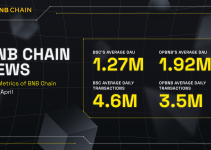Table of Contents

The blockchain ecosystem has witnessed remarkable growth over the years, transforming various industries and paving the way for decentralized applications. However, as the popularity of blockchain applications soared, scalability and high transaction fees became major bottlenecks on popular Layer 1 chains.
Layer 2 scaling solutions emerged to address these challenges, with OP Stack leading the way as a modular and interoperable framework. In this article, we delve into the different OP Stack implementations and explore the relevance of OP Stack in the blockchain space. Additionally, we’ll highlight how opBNB stands out with unique features and improvements.
Understanding OP Stack: A Modular Approach to Scaling
OP Stack is a groundbreaking framework that aims to enhance the scalability and interoperability of various blockchains. Built on utility, simplicity, and extensibility principles, OP Stack allows developers to build highly scalable and decentralized applications without compromising security.
OP Mainnet serves as the foundation of the OP Stack ecosystem. It introduces the concept of sequencers, provers, and verifiers, ensuring secure state transitions and transactions. The roll-up built on OP Mainnet allows efficient and cost-effective scaling, providing throughput beyond Layer 1 constraints. Moreover, OP Mainnet leverages Ethereum’s EVM (Ethereum Virtual Machine) compatibility, enabling developers to port their existing smart contracts seamlessly.
OP Arbitrum is a notable implementation of OP Stack, specifically focusing on Ethereum Layer 2 scaling solutions. With its unique design, OP Arbitrum allows for fast and secure execution of smart contracts while significantly reducing gas fees. By leveraging zero-knowledge proofs, OP Arbitrum proves that the Layer 2 nodes performed their tasks correctly, enhancing its security.
OP Optimism is similar to OP Arbitrum, targeting Ethereum Layer 2 scalability. This implementation is known for its compatibility with Ethereum’s EVM and Solidity, providing a familiar environment for developers to build applications. Using OP Optimism, users can enjoy faster and cheaper transactions, making it an attractive solution for high-volume applications like games and DeFi.
The emergence of OP Stack has revolutionized the scalability and usability of blockchain applications, addressing critical pain points and opening doors for innovation. Its modular approach ensures developers can select and customize components to suit their needs, enabling seamless integration with existing infrastructure. OP Stack’s commitment to open-source development fosters a collaborative environment where projects can collaborate and benefit from each other’s advancements, promoting a thriving and interconnected blockchain ecosystem.
Why opBNB Stands Out: A Different Perspective
opBNB is a high-performance optimistic rollup designed specifically for BNB Smart Chain (BSC), built on the solid foundation of OP Stack. What sets opBNB apart from other OP Stack implementations is its focus on catering to the unique requirements and challenges of the BSC ecosystem.
Lower Gas Fees and Higher Block Gas Limits
opBNB prioritizes user experience by offering lower gas fees than other Layer 2 solutions like OP Optimism and OP Arbitrum. With a gas fee of $0.005, opBNB significantly reduces the cost burden on users, making it more affordable for high-frequency transactions and applications.
Moreover, opBNB boasts a higher block gas limit of 100,000,000 gas, surpassing the 30,000,000 gas limit on OP Optimism and 32,000,000 gas limit on OP Arbitrum. This higher block gas limit enhances opBNB’s scalability, allowing it to handle more transactions in a single block, even during peak traffic.
Flexible Execution Client Options
One of opBNB’s key advantages lies in its modular and replaceable execution design. This unique approach empowers developers to execute smart contracts using various client options, ensuring decentralization and performance optimization. This flexibility strengthens opBNB’s resilience and adaptability, allowing it to cater to different use cases and preferences within the BSC ecosystem.
Leveraging the BNB Chain Ecosystem
Being native to BNBSmart Chain, opBNB can leverage the robust BNB Chain ecosystem. With millions of loyal users and a thriving community, opBNB gains a competitive edge over other Layer 2 platforms lacking an extensive user base. This strong network effect fosters growth and adoption and reduces the need for extensive marketing efforts and customer acquisition.
Conclusion
OP Stack has emerged as a revolutionary framework in the blockchain space, providing modular and interoperable solutions to scalability challenges. With OP Mainnet, OP Arbitrum, and OP Optimism leading the way, developers have diverse tools to enhance their applications’ performance and user experience. In this promising landscape, opBNB shines as a high-performance optimistic rollup dedicated to BNBSmart Chain.
With its focus on lower gas fees, higher block gas limits, flexible execution options, and integration with the BNB Chain ecosystem, opBNB stands out as a compelling choice for developers seeking scalability and cost-effectiveness within the BSC ecosystem.
As the blockchain space continues to evolve, OP Stack and its different implementations, including opBNB, promise to drive further innovation and empower the development of decentralized applications for a more interconnected future. To learn how L2 solutions like opBNB enhance performance and improve cost savings, read BNB Chain’s in-depth explanation here.
Ready to Deploy on BNB Chain? Let’s Make It Happen Together! Reach out to us here.


